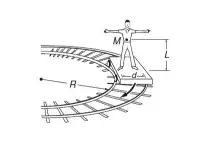In general, the angular momentum of a system of particles about a reference point is equal to the angular momentum of the center of mass (CM) about the point plus the angular momentum of the motion about the CM. Using the CM as the reference point, the angular momentum of the CM is always zero so the angular momentum of the system is the angular momentum about the CM.
In your case, the angular momentum of the person about the CM is zero assuming the person is not swaying, but the CM of the person has linear acceleration inward due to the centripetal force from friction. For a body that is accelerating, if you take the reference point at the CM it is always true that ${d \vec L_{CM} \over dt} = \vec \tau_{CM}$, where $\vec L_{CM}$ is the angular momentum and $\vec \tau_{CM}$ is the net external torque about the CM; basic physics texts state this, which is true, without proof. It is not true in general that ${d \vec L_Q \over dt} = \vec \tau_Q$ for any reference point Q other than the CM if the body is accelerating; for proof see a physics mechanics text such as Mechanics by Symon, or Classical Mechanics by Goldstein. Since the angular momentum of the person about the CM is zero, the total angular momentum with respect to the CM is zero; therefore, the sum of the torques about the CM is zero as indicated in the solution, even though the CM is accelerating inward.
You can use a reference point $Q$ that is not the CM, but there is an extra term for torque in this case. Specifically, ${d \vec L_Q \over dt} = \vec \tau_Q -M(\vec R - {\vec r_Q}) \times \ddot {\vec r_Q}$ where $M$ is the mass, $\vec R$ is the position of the CM with respect to the origin of your inertial system, and $\vec r_Q$ is the position of point Q with respect to the origin of your inertial system. In general this can be complicated to evaluate, but for your case: $-M(\vec R - {\vec r_Q})$ is a vector downwards with magnitude $Mh$ where $h$ is the distance from the point Q (the point between the feet) and the CM, $\ddot {\vec r_Q}$ is a vector inwards with magnitude ${v^2 \over R}$. Also, $\vec L_Q$ is zero since there is no sway of the person about the point Q between the feet. Taking the vector directions into account we have: $0 = (N_1 - N_2){d \over 2} - {Mhv^2 \over R}$, or $(N_1 - N_2){d \over 2} = {Mhv^2 \over R}$. Note: I use $h$ instead of $L$ for the distance from $Q$ to the CM because I reserve $L$ to mean angular momentum.
You obtain the same answer for the normal forces using the CM or the point between the feet as your reference point, but in general you should always use the CM as the reference point for an accelerating body, because the evaluation using another point can be very complex.
Also see the question About $\frac{d L}{d t}=\tau$ in a rotating center of mass frame on this exchange. The answer @Kashmiri provides is essentially the same as I provide here.

